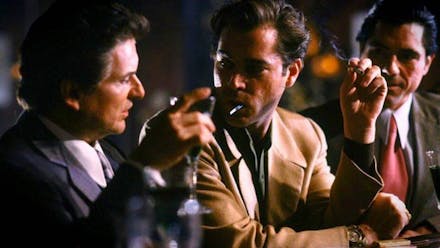
In 1985, when he was in the middle of shooting The Color Of Money, Martin Scorsese didn't think there was much future in the gangster movie. Not only had he already visited that territory with his triumphant calling-card Mean Streets in 1973, but the final word seemed to have been delivered by Francis Ford Coppola with The Godfather the previous year. "There's no sense in making another gangster picture, unless it's as close as possible to a certain kind of reality, to the spirit of a documentary," he said. Nothing seemed to suggest itself. Then he was handed the galley proofs for a not-yet published book, Wise Guy by Nicholas Pileggi. And he changed his mind.
Scorsese delights in the technical possibilities of filmmaking.
Pileggi's book, a non-fiction account of the life and crimes of Henry Hill based upon interviews with Hill after he entered the witness protection programme, meshed perfectly with Scorsese's early memories of peering out of his window in Little Italy and being, "Aware of these older men who had power without lifting a finger..." It's a child's eye view perfectly captured in the opening act of the movie, in which a young Henry (Christopher Serrone), mesmerised by the money and glamour of the neighbourhood thugs is slowly sucked into the milieu of the mobster. It's a story of seduction and in one of the blackest scenes he's "pinched" for the first time only to be greeted by a crowd of cheering hoods. These people are not only corrupt, they're worse; they rejoice in corrupting others. But there's no doubt where this path will lead. In one of the many freeze frames, which occur at the various key turning points in the film, young Henry is seen silhouetted against a bright orange cumulus of fire from an exploding car yard. You don't need to be a Catholic like Scorsese to work out where Hill is headed.

But it's in the second act that the movie really takes off. Here we see the GoodFellas in their element and Scorsese in his. There are too many great moments to list: Tommy's (Joe Pesci) "You think I'm funny?" tirade in the restaurant (all improvised); Jimmy (Robert De Niro) sitting at a bar, not moving a muscle and yet somehow managing to convey with still, gimlet eyes that, by the end of Scorsese's slow zoom, he's decided to execute Morey (Chuck Low); the breathtaking steadicam trip through a nightclub's kitchens (unplanned — Scorsese couldn't get permission to go in the front way so devised the incredible sequence on the hop).
Scorsese delights in the technical possibilities of filmmaking. There are flash cuts, freeze frames, crash zooms, montage, the most systematic, brilliant use of score both over and under the action in cinema and an audacious voiceover (often the sign of lazy storytelling — here an integral part of the movie). This is look ma, no hands! filmmaking and as critic Pauline Kael pointed out, the reason that this movie above all others appealed to the twentysomething film enthusiasts of 1990 was that it was akin to going to a gig and wishing you were in the band. "They don't just respond to his films," she wrote, "they want to be him."
Everyone gets what's coming to them.
But there's much more lurking underneath the bravura direction. Unlike Coppola's Godfather, which elevates its characters to the level of players in some grand opera, GoodFellas slyly undermines the swagger of the gangsters, presenting them instead as pathetic characters trapped in a bubble of ostentatious bad taste.
There is the constant vulgar waving around of $20 bills, the grotesque soft furnishings, the mink coats and pink Cadillacs. These are loathsome yuppies with firearms, and it's surely no accident that GoodFellas found success in 1990, the year that this kind of garish conspicuous consumption began to be decried.
Not only that, these are criminals who carry with them the seeds of their own destruction. Their greed, ego and corruption conspire satisfyingly against them. The gang that pull off the giant airport heist are systematically murdered by Jimmy, while Tommy has the arrogance to think he can mess with the Mafia, and pays for it by being shot in the head. Everyone gets what's coming to them and in the end Henry's fate is particularly appropriate. He may not wind up in the inferno that Scorsese suggests at the start of the movie, but he's in a perfectly-realised personal purgatory; rotting in the Witness Protection Programme, the boy who ever since he could remember, "wanted to be a gangster", winding up as an "ordinary schnook".

It is of course a little too perfect to be true. In an ironic kicker, in real-life, Hill used his new identity to embark on yet more crime and was summarily kicked out of the programme a few years later.
